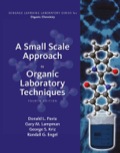
Interpretation:
The reason for no crystallization of the sulfanilamide in the give experimental procedure needs to be explained.
Concept Introduction:
Crystallization is explained as a procedure by which formation of crystal or solid takes place by precipitating them from the solution. It takes place by either supercooling the solution liquid or by supersaturated solvent.
Answer to Problem 1Q
Crystallization of sulfanilamide did not occur because of the proper ratio of solute and solvent is not taken in dissolving.
Explanation of Solution
Given Information:
10 mL volume of 95% ethyl alcohol is added to impure sulfanilamide of mass 0.10 g. After dissolving the solid, solution is cooled to room temperature and placed on ice-water bath for crystallization.
Sulfanilamide contains both polar sulfonamide,
Want to see more full solutions like this?
Chapter 2 Solutions
EBK A SMALL SCALE APPROACH TO ORGANIC L
- Amoxicillin is an antibiotic packaged as a powder. When it is used to treat babies and small animals, the pharmacist or veterinarian must suspend it in water, so that it can be administered orally with a medicine dropper. The label says to dispose of unused suspension after 14 days. It also points out that refrigeration is required. In the context of this chapter, what is implied in the latter two statements?arrow_forwardMacmillan Learning In yeast, ethanol is produced from glucose under anaerobic conditions. A cell-free yeast extract is placed in a solution that contains 3.00 × 10² mmol glucose, 0.40 mmol ADP, 0.40 mmol P₁, 0.80 mmol ATP, 0.20 mmol NAD+, and 0.20 mmol NADH. It is kept under anaerobic conditions. What is the maximum amount of ethanol (in millimoles) that could theoretically be produced under these conditions? maximum amount of ethanol: mmol Under the same conditions, what is the theoretical minimum amount of glucose (in millimoles) required in the solution to form the maximum amount of ethanol? minimum amount of glucose required: mmolarrow_forwardConsider the reaction: Nio (s) + CO (9) = Ni (s) + CO2 (g) K. =4000.0 at 1500 K When calculating the answer, do not round to the appropriate number of significant figures until the last calculation step.arrow_forward
- 1) Use Hess's Law to determine AH for the following target reaction. 3 CO₂(g) + 4 H₂O(g) b) C3Hg(g) + 5 O₂(g) C(s) + O₂(g) -CO₂(g) 2 H₂(g) + O₂(g) 3 C(s) + 4 H₂(g) →→→ 2 H₂O(g) C3H8(g) AH = AH = ΔΗ ΔΗ = ??? -2043 kJ -393.5 kJ -483.6 kJarrow_forwardA reaction that can be run at 350 K for 12 h without a catalyst or one that can be run at 300 K for 1 h with a reusable catalystarrow_forwardArrange the following reactions in order of their increasing tendency to go toward completion: Reaction # Reaction Kc 2 CH4(g)SC2H6(g) + H2(g) 9.5 x 10 13 HCHO2(g) SCO(g)+ H20(g) 4.3 x 105 4.2x 10 3 N20 + NO2(g) =3 NO(g) 4. 0 (2) < (3) < (1) O (3) < (2) < (1) O (1) < (3) < (2) O (2) < (1) < (3) search 0耳會 2.arrow_forward
- A student determines the molar mass of acetone by the method used in this experiment. She found that the equilibrium temperature of a mixture of ice and water was 0.5 C on her thermometer. When she added 10.5 g of her sample to the mixture, the temperature fell to -3.7 C. She then poured off the solution through a screen into a beaker. The mass of the solution was 86.4 g. How much acetone was in the decanted solution?arrow_forwardFor the reaction A(g) + 7B(g) D C(g) + 4D(g), if Kp = 0.57 @ 105 K, what is the value of Kc at this temperature? Kp = Kc(RT)Δn R = 0.0821 Latm/molK Enter your answer as a standard number with 3 significant figures.arrow_forwardCould someone Please Help Me with this! No Plagirism Please! 3 · Provide at least 1 example of a reversible process (either physical or chemical). What has to be done to the process to make it reverse? Part 2—Copper (II) Chloride System - Cu(H2O)62+(aq) + 4Cl–(aq) + heat ⇆ CuCl42–(aq) + 6H2O(l) Blue Green Test Tube Procedure (Impacts) Predictions Observations (Result/Shift) 1 No tests (control) 2 Add 4M NaCl dropwise until change is observed *increases concentration of Cl─ in the system 3 Add 0.05M AgNO3 drop-wise until change is observed *decreases concentration of Cl─ in the system 4 Add H2O dropwise until change is observed *increases concentration of H2O in the system 5 Add acetone dropwise until change is observed *decreases concentration of H2O in the system 6 Place in hot water bath for 1-2 minutes *adds heat to the reaction system…arrow_forward
- What is a nonspontaneous reaction?arrow_forwardGive 1 example of a fruitful and unfruitful collision in your daily activities.arrow_forwardCH3CHO + 2H+ + 2e¯ → C2H5OH, with ECH, CHO -0.19 v NAD+ + H+ + 2e¯ → NADH, with E ´NAD+ -0.32 v 1. If acetaldehyde (CH3CHO) and ethanol (C2H5OH) are mixed in the presence of NAD+ and NADH, a chemical reaction starts. Use the information above to determine the balanced chemical equation for the overall reaction that occurs spontaneously. Explain how you know that your reaction proceeds spontaneously in the direction indicated in your chemical equation. 2. In the liver, the enzyme called alcohol dehydrogenase catalyzes the conversion of ethanol to acetaldehyde. If the reaction is allowed to proceed until equilibrium is established, how would the reaction mixture respond to the addition of the enzyme? Explain your reasoning.arrow_forward
 EBK A SMALL SCALE APPROACH TO ORGANIC LChemistryISBN:9781305446021Author:LampmanPublisher:CENGAGE LEARNING - CONSIGNMENT
EBK A SMALL SCALE APPROACH TO ORGANIC LChemistryISBN:9781305446021Author:LampmanPublisher:CENGAGE LEARNING - CONSIGNMENT Chemistry for Engineering StudentsChemistryISBN:9781337398909Author:Lawrence S. Brown, Tom HolmePublisher:Cengage Learning
Chemistry for Engineering StudentsChemistryISBN:9781337398909Author:Lawrence S. Brown, Tom HolmePublisher:Cengage Learning Chemistry: The Molecular ScienceChemistryISBN:9781285199047Author:John W. Moore, Conrad L. StanitskiPublisher:Cengage Learning
Chemistry: The Molecular ScienceChemistryISBN:9781285199047Author:John W. Moore, Conrad L. StanitskiPublisher:Cengage Learning


